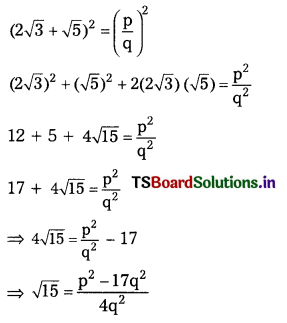Students can practice TS 10th Class Maths Solutions Chapter 1 Real Numbers Optional Exercise to get the best methods of solving problems.
TS 10th Class Maths Solutions Chapter 1 Real Numbers Optional Exercise
Question 1.
Can the number 6n, n being a natural number, end with the digit 5 ? Give reason.
Solution:
Given number = 6n; n ∈ N
6n to be end in 5; it should be divisible by 5.
6n = (2 × 3)n
The prime factors of 6n are 2 and 3.
∴ It can’t end with the digit 5.
Question 2.
Is 7 × 5 × 3 × 2 + 3 a composite number? Justify your answer.
Solution:
Given : 7 × 5 × 3 × 2 + 3
= 3(7 × 5 × 2 + 1)
= 3 × (70 + 1)
= 3 × 71
The given number has two factors namely 3 and 71.
∴ Hence it is a composite number.
![]()
Question 3.
Prove that (2\(\sqrt{3}\) + \(\sqrt{5}\) is an irrational number. Also check whether (2\(\sqrt{3}\) + \(\sqrt{5}\))(2\(\sqrt{3}\) – \(\sqrt{5}\)) is rational or irrational.
Solution:
To prove : 2\(\sqrt{3}\) + \(\sqrt{5}\) is an irrational number. On contrary, let us suppose that 2\(\sqrt{3}\) + \(\sqrt{5}\) be a rational number then 2\(\sqrt{3}\) + \(\sqrt{5}\) = \(\frac{\mathrm{p}}{\mathrm{q}}\)
Squaring on both sides, we get

L.H.S = an irrational number
R.H.S. = p, q being integers, \(\frac{p^2-17 q^2}{4 q^2}\) is a rational number.
This is a contradiction to the fact that \(\sqrt{15}\) is an irrational. This is due to our assumption that 2\(\sqrt{3}\) + \(\sqrt{5}\) is a rational. Hence our assumption is wrong and 2\(\sqrt{3}\) + \(\sqrt{5}\) is an irrational number.
Also,
(2\(\sqrt{3}\) + \(\sqrt{5}\)) (2\(\sqrt{3}\) – \(\sqrt{5}\)) = (2\(\sqrt{3}\))2 -(\(\sqrt{5}\))2
[∵ (a + b) (a – b) = a2 – b2]
= 4 × 3 – 5 = 12 – 5 = 7, a rational number.
![]()
Question 4.
If x2 + y2 = 6xy, prove that 2 log (x +y) = logx + logy + 3 log 2
Solution:
Given : x2 + y22 = 6xy Adding both sides
⇒ x2 + y2 + 2xy = 6xy + 2xy (x + y)2 = 8xy
Taking logarithms on both sides
log (x + y)2 = log 8xy
⇒ 2 log(x + y) = log 8 + log x + log y
[∵ log xm = mlog x]
[∵ log xy = log x + log y]
= log 23 + log x + log y
⇒ 2log (x + y) = log x + log y + 3 log 2
Question 5.
Find the number of digits in 42013, if log10 2 = 0.3010.
Solution:
Given log102 = 0.3010
42013 = (22)2013 = 24026
∴ log10 24026 = 4026 log 2
[∵ log xm = m log x]
= 4026 × 0.3010
= 1211.826 \(\simeq\) 1212
∴ 42013 has 1212 digits in its expansion.